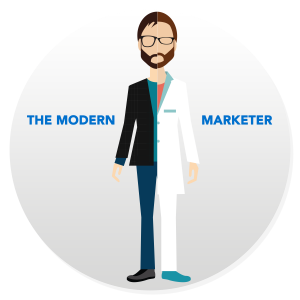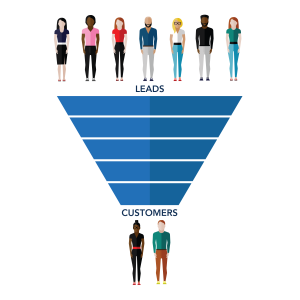Marketing as we know it is in the midst of a massive transformation. Are you prepared for the new reality, and ready to enter the new age of Modern Marketing?
Way back in 1898, American Sales and Marketing pioneer named Elias Lewis (no relation that I know of!) wrote and spoke extensively about how advertising could educate the public, and about what it takes to attract and hold the attention of a consumer. He analyzed the consumer’s buying process and defined the stages of Attention, Interest, Desire, and Action — commonly known by the acronym AIDA — that we still use today. And while that process has not changed in over 100 years, today the entire process can occur in the palm of the consumer’s hand.
Ever since 1991, when the Internet made its official debut, the World Wide Web has become a global platform for accelerating the flow of information, and it’s pushing many traditional forms of media and commerce into obsolescence. In fact, online sales for Black Friday 2015 hit $4.5 billion, and an incredible 34% of those purchases took place on mobile. Consumers can go from click to close, from awareness to ownership, in seconds now. Sales, Marketing, and Customer Service are now pretty much open 24/7 in this digital age. Undeniably, the Internet has forever changed the way prospects and customers engage with businesses.
So how should you adapt your marketing efforts to this era of dramatic change?
Understanding the New “Modern Marketing”
The place to start is by accepting that your role in Marketing now focuses on driving revenue and growth. I believe that, over the past decade more than any other, the spotlight has shifted frocccm Sales to Marketing because of two key factors:
- Anytime, Anywhere Access. The first factor is that buyers have access to brands anytime, anywhere. As marketers, we are taking on many of the functions for which Sales was traditionally responsible. We create attention, interest, desire, and action without ever having a face-to-face or voice conversation with billions of customers every year. Just think for a moment about all of the software and apps that are downloaded and used by our customers without ever engaging with Sales.
Think about all the billions of dollars of goods that are purchased online and shipped to doorsteps without interaction by a Salesperson. While the psychology of buying hasn’t changed, the process looks nothing like it did even a few years ago — and it will continue to change. When I’m talking to my kids, it seems like “instant gratification is no longer fast enough.” But I believe that’s the mindset of the millennial generation.
The point is, we are approaching that tipping point where e-commerce is overtaking street commerce. And you know what? This dramatic change is shifting the balance of power to you, the Marketing team. - The Marketing Cloud. The second factor that has put Marketing in the spotlight for growth is the advent of the Marketing Cloud. The Marketing Cloud is a new category of Marketing tools and technologies that enables Marketing to find, target, market to, and engage with buyers and customers like never before. These new tools also enables Marketing to manage the demand it creates.
A decade ago, the tools you had were focused on helping you with the art of Marketing, like advertising, branding, packaging, and direct mail. But now we have tools that enable us to construct an entire Demand Factory™: my metaphor where leads are analogous to raw materials and the output is customers.
Yet, while Marketing is becoming the powerhouse of business growth, Sales still plays a vital role, especially in what are called “considered purchases” and complex sales cycles. These types of sales, such as high-ticket items and sophisticated products, require Sales to engage with prospects by phone, face to face, or both. They also involve lots of discussions, negotiations, and demonstrations; often a buying committee is involved, rather than just a single decision maker. In these situations, our metaphorical Demand Factory has to support longer sales cycles involving lots of moving parts and parties — so it’s vital that the systems and roles are synchronized between Sales and Marketing.
But the need for alignment between Sales and Marketing systems goes far beyond just these complex or expensive sales. We must also be in sync when Marketing is generating high volumes of respondents to campaigns: when there are hundreds or even thousands of respondents to a campaign, we have to help Sales prioritize follow-ups. And we have to maintain engagement with these leads, especially the ones that aren’t ready for hand off to Sales yet.
So yes, Marketing has risen to the ranks of driving growth, but whether we are running campaigns that go from click to close in seconds, or driving leads through complex, longer-term sales, we still need a better process for managing demand. That’s why we must re-engineer our Sales and Marketing systems and the methods of working together.
The Answer is Lead Management
So what do we need to do? It’s what modern marketing calls lead management. Lead management is a core system between Sales and Marketing that uses a Marketing Automation system like Marketo or Eloqua, a Sales CRM system, and a set of automated programs that links them to track and move leads through the buying process. These lead management programs include lead scoring, lead nurturing, and an overall means to track and manage the contacts at each stage of generation.
 A lead management framework is vital today because the old, “throw all the leads over to Sales” model just doesn’t work anymore. Virtually every marketer has heard the complaint from Sales: “All your lead suck, especially when we generate high volumes of respondents.” And Marketing, of course, gets frustrated that Sales doesn’t follow up on all the leads generated. The finger-pointing and blame game stems from a lack of process and of an agreed-upon definition of a qualified lead. Lead management solves all of that.
A lead management framework is vital today because the old, “throw all the leads over to Sales” model just doesn’t work anymore. Virtually every marketer has heard the complaint from Sales: “All your lead suck, especially when we generate high volumes of respondents.” And Marketing, of course, gets frustrated that Sales doesn’t follow up on all the leads generated. The finger-pointing and blame game stems from a lack of process and of an agreed-upon definition of a qualified lead. Lead management solves all of that.
Here’s how lead management works. Historically, Sales considers a lead to be someone who’s ready to talk to them now and who can approve and fund the purchase. Marketing, however, has traditionally used the term “lead” to mean anyone who has responded in any way to a campaign. So the first step in lead management and improving alignment between Sales and Marketing is to create a new process for demand generation that represents each of the stages buyers go through, with a shared vocabulary to describe them.
Managing Lead Inventory with the Demand Funnel
The model most often used is called the Demand Funnel. Essentially, it’s an inventory management system of all the demand we generate in the Demand Factory, and it helps us manage engagement at each stage of the process from inquiry to customer. It sometimes has other names, like the Demand Waterfall, or the Sales and Marketing Pipeline, but whatever name is used for it, it’s a model for grouping similar prospective customers into stages that represent their progress through a multi-stage buying process.
Creating the definitions and names for the Demand Funnel stages is typically a joint exercise between Sales and Marketing; doing this process together is an important catalyst for achieving process alignment. Sales and Marketing not only agree upon the stage names and definitions, but also agree which department owns each stage, and what the engagement plan is for the team assigned to that stage. Simply creating the stages and documenting the Demand Funnel, however, is nowhere near enough. It has to be operationalized in the systems used by both Marketing and Sales.
Think about the shape of the Demand Funnel. Typically, the narrowest part, the bottom, has the Sales staff assigned to it. The upper part, the widest part where all the prospects enter, is normally the responsibility of the Marketing team. As marketers, our job is to generate a lot of responses to fill that funnel, making the top as wide as possible. But as the shape suggests, fewer and fewer prospects will move down to the bottom, which is why we need a well-defined system to track inventory levels and conversion rates for each stage. We also need to account for all the recycling that occurs when prospects fall out of the funnel because they are not ready to buy yet.
So defining and operationalizing the Demand Funnel in our Marketing Automation and CRM systems, are the first steps towards having a lead management framework and system.
Moving to the Next Phase
The next phase of setting up lead management is to implement a lead scoring system and one or more lead nurturing programs. The lead scoring system will help Sales prioritize which leads to follow up on, and it will route the various scored leads into corresponding nurture programs that will automate engagement with prospects. Remember AIDA? Both lead scoring and lead nurturing take the Awareness we generate and move it through the Demand Factory to Interest, Desire, and Action.
For now, what’s important is shifting your mindset from lead generation to lead management. No longer is Marketing throwing leads over the wall to Sales. “Modern Marketing” is about teamwork within our Demand Factory: having a lead management framework and a system for managing and measuring the demand we create, either for ecommerce or for our Sales team (or both).
There has never been a better time to be in Marketing. We’ve never before had the tools for managing everything from click to close. In the age of Modern Marketing, the best marketing wins — and that starts with understanding of your new responsibilities and the power that comes with them.
Interested in modern marketing? Check out some of our related content; Make Marketing Matter or if you would like to get in touch drop us a note!
______
 For more than 20 years, David Lewis has been a pioneering innovator in digital marketing, and has overseen marketing for some of Silicon Valley’s leading technology firms. Taking his expertise for “Making Marketing Matter”, he founded DemandGen in 2007 to build the worlds’ first marketing technology agency.
For more than 20 years, David Lewis has been a pioneering innovator in digital marketing, and has overseen marketing for some of Silicon Valley’s leading technology firms. Taking his expertise for “Making Marketing Matter”, he founded DemandGen in 2007 to build the worlds’ first marketing technology agency.
For the past decade, David and his team at DemandGen have been at the forefront of the transformation taking place in marketing by helping 100’s of the top sales and marketing teams around the world incorporate marketing automation to drive growth. David is an accomplished industry speaker, thought leader, and author. His ground-breaking work on the transformation of marketing and sales is at the heart of his book, Manufacturing Demand: The Principles of Successful Lead Management.
The post Transforming Yourself into a Modern Marketer appeared first on DemandGen.











